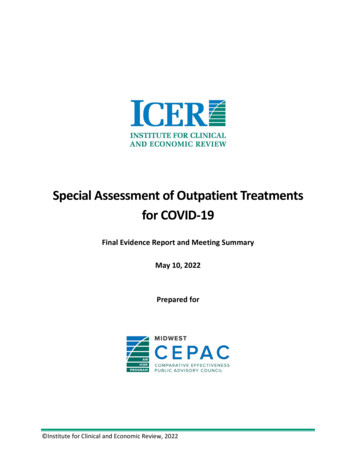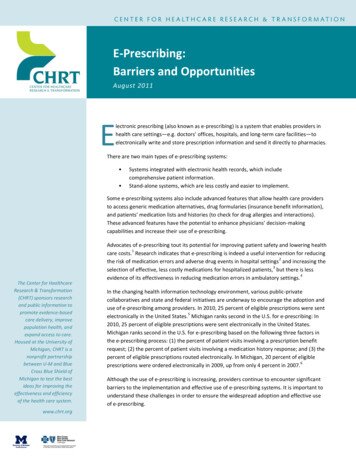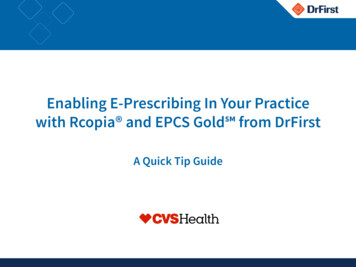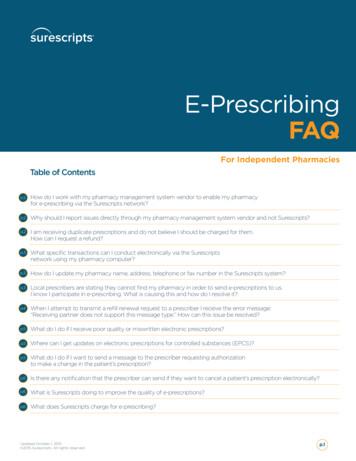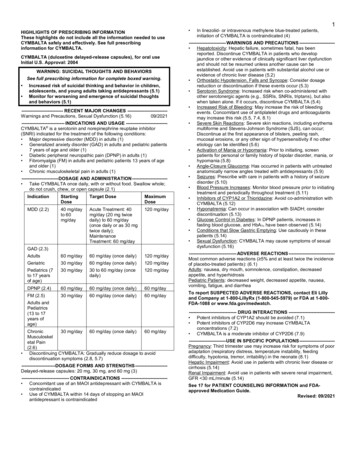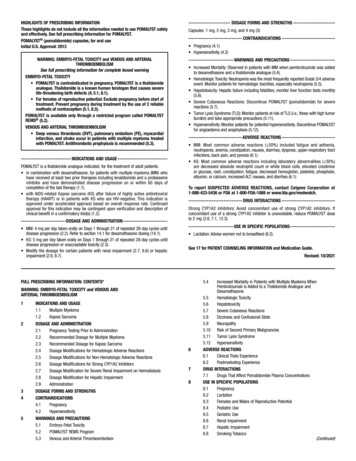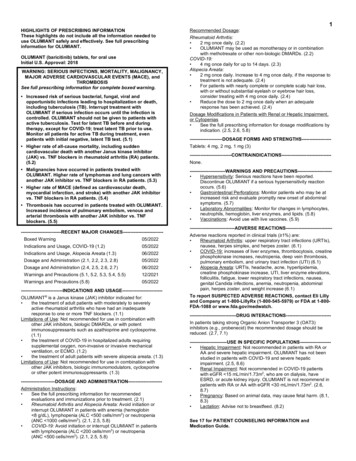
Transcription
HIGHLIGHTS OF PRESCRIBING INFORMATIONThese highlights do not include all the information needed to use HIZENTRAsafely and effectively. See full prescribing information for HIZENTRA.HIZENTRA , Immune Globulin Subcutaneous (Human), 20% LiquidInitial U.S. Approval: 2010WARNING: THROMBOSISSee full prescribing information for complete boxed warning. Thrombosis may occur with immune globulin products, includingHIZENTRA. Risk factors may include: advanced age, prolongedimmobilization, hypercoagulable conditions, history of venous orarterial thrombosis, use of estrogens, indwelling vascular catheters,hyperviscosity, and cardiovascular risk factors. For patients at risk of thrombosis, administer HIZENTRA at the minimumdose and infusion rate practicable. Ensure adequate hydration in patientsbefore administration. Monitor for signs and symptoms of thrombosisand assess blood viscosity in patients at risk for --RECENT MAJOR CHANGE---------------------------------Dosage and Administration ICATIONS AND USAGE--------------------------------HIZENTRA is an Immune Globulin Subcutaneous (Human) (IGSC), 20% Liquid indicated forthe treatment of: Primary immunodeficiency (PI) in adults and pediatric patients 2 years of age and older. (1.1) Maintenance therapy in adults with chronic inflammatory demyelinating polyneuropathy(CIDP). (1.2)------------------------------DOSAGE AND ADMINISTRATION------------------------------For subcutaneous infusion only.Dose (2.2)PIBefore switching to HIZENTRA, obtain the patient’s serum IgG trough level to guide subsequent dose adjustments. Weekly: Start HIZENTRA 1 week after last Immune Globulin Intravenous (Human)(IGIV) infusion.Initial weekly dose Previous IGIV dose (in grams)x 1.37No. of weeks between IGIV doses Biweekly (every 2 weeks): Start HIZENTRA 1 or 2 weeks after the last IGIV infusion or1 week after the last weekly IGSC infusion. Administer twice the calculated weekly dose. Frequent dosing (2 to 7 times per week): Start HIZENTRA 1 week after the last IGIVor IGSC infusion. Divide the calculated weekly dose by the desired number of timesper week. Adjust the dose based on clinical response and serum IgG trough levels.CIDP Initiate therapy with HIZENTRA 1 week after the last IGIV infusion. Recommended subcutaneous dose is 0.2 g/kg (1 mL/kg) body weight per week.- In the clinical study after transitioning from IGIV to HIZENTRA, a dose of 0.4 g/kg(2 mL/kg) body weight per week was also safe and effective to prevent CIDP relapse. If CIDP symptoms worsen, on 0.2 g/kg (1 mL/kg) body weight per week, considerincreasing the HIZENTRA dose from 0.2 g/kg to 0.4 g/kg body weight per week.If CIDP symptoms worsen on 0.4 g/kg body weight per week, consider re-initiatingtherapy with IGIV, while discontinuing HIZENTRA. Monitor patient’s clinical response and adjust duration of therapy based on patient need.FULL PRESCRIBING INFORMATION: CONTENTS*WARNING: THROMBOSIS1 INDICATIONS AND USAGE1.1 Primary Immunodeficiency (PI)1.2 Chronic Inflammatory Demyelinating Polyneuropathy (CIDP)2 DOSAGE AND ADMINISTRATION2.1 Preparation and Handling2.2 Dose2.3 Administration3 DOSAGE FORMS AND STRENGTHS4 CONTRAINDICATIONS5 WARNINGS AND PRECAUTIONS5.1 Hypersensitivity5.2 Thrombosis5.3 Aseptic Meningitis Syndrome (AMS)5.4 Renal Dysfunction/Failure5.5 Hemolysis5.6 Transfusion-Related Acute Lung Injury (TRALI)5.7 Transmissible Infectious Agents5.8 Laboratory Tests6 ADVERSE REACTIONS6.1 Clinical Trials Experience6.2 Postmarketing ExperienceAdministration (2.3) PI: Administer at regular intervals from daily up to every 2 weeks. CIDP: Administer weekly. Infusion sites – Up to 8 infusion sites are allowed simultaneously, with at least 2inches between sites.Administration in PIInfusion Parameters*1st InfusionSubsequent InfusionsVolume (mL/site) 15 25Rate (mL/hr/site) 15 25*As toleratedAdministration in CIDPInfusion Parameters*Volume (mL/site)Rate (mL/hr/site)* As tolerated1st Infusion 20 20Subsequent Infusions 50 50----------------------------DOSAGE FORMS AND STRENGTHS-----------------------------0.2 g per mL (20%) protein solution for subcutaneous infusion available in a single-doseprefilled syringe (5 mL,10 mL, and 20 mL) or tamper-evident vial (5, 10, 20 and 50 mL). CATIONS------------------------------------- Anaphylactic or severe systemic reaction to human immune globulin or inactiveingredients of HIZENTRA, such as polysorbate 80. (4) Hyperprolinemia Type I or II (HIZENTRA contains stabilizer L-proline). (4) IgA-deficient patients with antibodies against IgA and a history of hypersensitivity. (4)---------------------------------WARNINGS AND PRECAUTIONS--------------------------- IgA-deficient patients with anti-IgA antibodies are at greater risk of severe hypersensitivityand anaphylactic reactions. (5.1) Thrombosis may occur following treatment with immune globulin products, includingHIZENTRA. (5.2) Aseptic meningitis syndrome has been reported with IGIV or IGSC, including HIZENTRAtreatment. (5.3) Monitor renal function, including blood urea nitrogen, serum creatinine, and urine outputin patients at risk of acute renal failure. (5.4) Monitor for clinical signs and symptoms of hemolysis. (5.5) Monitor for pulmonary adverse reactions (transfusion-related acute lung injury [TRALI]). (5.6) HIZENTRA is made from human blood and may contain infectious agents, e.g., viruses,the variant Creutzfeldt-Jakob disease (vCJD) agent and, theoretically, the CreutzfeldtJakob disease (CJD) agent. (5.7)-----------------------------------ADVERSE e most common adverse reactions observed in 5% of study subjects were local infusion site reactions, headache, diarrhea, fatigue, back pain, nausea, pain in extremity,cough, upper respiratory tract infection, rash, pruritus, vomiting, abdominal pain (upper),migraine, arthralgia, pain, fall and nasopharyngitis. (6)To report SUSPECTED ADVERSE REACTIONS, contact CSL Behring Pharmacovigilanceat 1-866-915-6958 or FDA at 1-800-FDA-1088 or ------DRUG The passive transfer of antibodies may interfere with the response to live virus vaccines(7.1), and lead to misinterpretation of the results of serological testing. (5.8, 7.2)See 17 for PATIENT COUNSELING INFORMATION and FDA-approved patient labeling.Revised: April 20227 DRUG INTERACTIONS7.1 Live Virus Vaccines7.2 Serological Testing8 USE IN SPECIFIC POPULATIONS8.1 Pregnancy8.2 Lactation8.4 Pediatric Use8.5 Geriatric Use11 DESCRIPTION12 CLINICAL PHARMACOLOGY12.1 Mechanism of Action12.3 Pharmacokinetics13 NONCLINICAL TOXICOLOGY13.1 Carcinogenesis, Mutagenesis, Impairment of Fertility13.2 Animal Toxicology and/or Pharmacology14 CLINICAL STUDIES14.1 Primary Immunodeficiency (PI)14.2 Chronic Inflammatory Demyelinating Polyneuropathy (CIDP)15 REFERENCES16 HOW SUPPLIED/STORAGE AND HANDLING17 PATIENT COUNSELING INFORMATION* Sections or subsections omitted from the full prescribing information are not listed.
HIZENTRA Immune Globulin Subcutaneous(Human), 20% LiquidFULL PRESCRIBING INFORMATIONWARNING: THROMBOSIS Thrombosis may occur with immune globulin products1-3, includingHIZENTRA. Risk factors may include: advanced age, prolongedimmobilization, hypercoagulable conditions, history of venous orarterial thrombosis, use of estrogens, indwelling central vascularcatheters, hyperviscosity, and cardiovascular risk factors. Thrombosismay occur in the absence of known risk factors [see Warnings andPrecautions (5.2), and Patient Counseling Information (17). For patients at risk of thrombosis, administer HIZENTRA at the minimumdose and infusion rate practicable. Ensure adequate hydration in patientsbefore administration. Monitor for signs and symptoms of thrombosisand assess blood viscosity in patients at risk for hyperviscosity [seeWarnings and Precautions (5.2)].1 INDICATIONS AND USAGEHIZENTRA is an Immune Globulin Subcutaneous (Human) (IGSC), 20% Liquid indicated forthe treatment of the following conditions:1.1 Primary Immunodeficiency (PI)HIZENTRA is indicated as replacement therapy for primary humoral immunodeficiency (PI)in adults and pediatric patients 2 years of age and older. This includes, but is not limitedto, the humoral immune defect in congenital agammaglobulinemia, common variableimmunodeficiency, X-linked agammaglobulinemia, Wiskott-Aldrich syndrome, and severecombined immunodeficiencies.1.2 Chronic Inflammatory Demyelinating Polyneuropathy (CIDP)HIZENTRA is indicated for the treatment of adult patients with chronic inflammatorydemyelinating polyneuropathy (CIDP) as maintenance therapy to prevent relapse ofneuromuscular disability and impairment.Limitations of Use:HIZENTRA maintenance therapy in CIDP has been systematically studied for 6 months andfor a further 12 months in a follow-up study. Maintenance therapy beyond these periodsshould be individualized based upon the patient’s response and need for continued therapy[see Dosage and Administration (2)].2 DOSAGE AND ADMINISTRATIONFor subcutaneous infusion only.2.1 Preparation and HandlingHIZENTRA is a clear and pale yellow to light brown solution. Do not use if the solution iscloudy or contains particulates. Prior to administration, visually inspect each prefilled syringe or vial of HIZENTRA forparticulate matter or discoloration, whenever the solution and container permit. Do not freeze. Do not use any solution that has been frozen. Check the product expiration date on the prefilled syringe or vial label. Do not usebeyond the expiration date. Do not mix HIZENTRA with other products. Do not shake the prefilled syringe or vial. Use aseptic technique when preparing and administering this product. Both the HIZENTRA prefilled syringe and vial are single‑dose containers. MultipleHIZENTRA prefilled syringes or vials can be administered to achieve the prescribed dose.Discard all used administration supplies and any unused product immediately after eachinfusion in accordance with local requirements.2.2 DosePrimary Immunodeficiency (PI) HIZENTRA can be administered at regular intervals from daily up to every 2 weeks(biweekly). Individualize the dose based on the patient’s clinical response to HIZENTRA therapy andserum immunoglobulin G (IgG) trough levels. Before receiving treatment with HIZENTRA:o Ensure that patients have received Immune Globulin Intravenous (Human) (IGIV)treatment at regular intervals for at least 3 months.o Obtain the patient’s serum IgG trough level to guide subsequent dose adjustments(see below, under Dose Adjustment).Dosage for patients switching to HIZENTRA from IGIV Establish the initial weekly dose of HIZENTRA by converting the monthly IGIV dose intoa weekly equivalent and increasing it using the dose adjustment factor. The goal is toachieve a systemic serum IgG exposure (area under the concentration-time curve [AUC])not inferior to that of the previous IGIV treatment.o To calculate the initial weekly dose of HIZENTRA, divide the previous IGIV dosein grams by the number of weeks between doses during the patient’s IGIVtreatment (e.g., 3 or 4); then multiply this by the dose adjustment factor of 1.37[see Clinical Pharmacology (12.3, Table 9)].Initial HIZENTRA dose Previous IGIV dose (in grams)x 1.37Number of weeks between IGIV doseso To convert the HIZENTRA dose (in grams) to milliliters (mL), multiply the calculateddose (in grams) by 5. Provided the total weekly dose is maintained, any dosing interval from daily up tobiweekly can be used and will result in systemic serum IgG exposure that is comparableto the previous IGIV or weekly HIZENTRA treatment [see Clinical Pharmacology (12.3)]. For biweekly dosing, multiply the calculated HIZENTRA weekly dose by 2. For frequent dosing (2 to 7 times per week), divide the calculated weekly dose by thedesired number of times per week (e.g., for 3 times per week dosing, divide weeklydose by 3).Dosage for patients switching to HIZENTRA from IGSC The previous weekly IGSC dose should be maintained. For biweekly dosing, multiply the previous weekly dose by 2. For frequent dosing (2 to 7 times per week), divide the previous weekly dose by thedesired number of times per week (e.g., for 3 times per week dosing, divide weeklydose by 3).Start HIZENTRA treatment For weekly or frequent dosing, start treatment with HIZENTRA 1 week after the patient’slast IGIV infusion or IGSC infusion. For biweekly dosing, start treatment 1 or 2 weeks after the last IGIV infusion or 1 weekafter the last weekly IGSC infusion.Dose AdjustmentThe dose may need to be adjusted to achieve the desired clinical response and serum IgGtrough level, irrespective of the frequency of administration.To determine if a dose adjustment should be considered, measure the patient’s serum IgGtrough level 2 to 3 months after switching to HIZENTRA.Weekly dosing: When switching from IGIV to weekly HIZENTRA dosing, the target serumIgG trough level is projected to be approximately 16% higher than the last trough levelduring prior IGIV therapy [see Clinical Pharmacology (12.3)].Biweekly dosing: When switching from IGIV to biweekly HIZENTRA dosing, the targetserum IgG trough level is projected to be approximately 10% higher than the last IGIVtrough level. When switching from weekly to biweekly dosing, the target trough is projectedto be approximately 5% lower than the last trough level on weekly therapy [see ClinicalPharmacology (12.3)].Frequent dosing: When switching from weekly dosing to more frequent dosing, thetarget serum IgG trough level is projected to be approximately 3 to 4% higher than the lasttrough level on weekly therapy [see Clinical Pharmacology (12.3)].To adjust the dose based on serum trough levels, calculate the difference (in mg/dL)between the patient’s IgG trough level obtained 2 to 3 months following the switchfrom IGIV or the last IGSC dose adjustment and the target IgG trough level for weeklyor biweekly dosing. Then find this difference in Table 1 (Column 1) and, based on theHIZENTRA dosing frequency (for weekly or biweekly) and the patient’s body weight, locatethe corresponding adjustment amount (in mL) by which to increase (or decrease) the dose.For frequent dosing, add the weekly increment from Table 1 to the weekly-equivalent doseand then divide by the number of days of dosing.Use the patient’s clinical response as the primary consideration in doseadjustment. Additional dosage increments may be indicated based on thepatient’s clinical response (infection frequency and severity).Table 1. Incremental Adjustment (mL)* of the HIZENTRA Dose† Based on theDifference ( mg/dL) from the Target Serum IgG Trough LevelDifferenceFrom TargetDosingSerum IgGFrequencyTrough eklyWeekly‡BiweeklyWeight Adjusted Dose Increment (mL)*Weight Group 10 to 30 kgn/a52.55510 30 to 50 kg2.555101020 50 to 70 kg51010201530 70 to 90 90kgkg51010201015203020304060n/a, not applicable.* Incremental adjustments based on slopes of the pharmacometric model-predicted relationship between serum IgGtrough level and HIZENTRA dose increments of 1 mg/kg per week.† Includes biweekly, weekly or frequent dosing.‡ To determine the dose increment for frequent dosing, add the weekly increment to the weekly-equivalent dose and thendivide by the number of days of dosing.For example, if a patient with a body weight of 70 kg has an actual IgG trough level
of 900 mg/dL and the target trough level is 1000 mg/dL, this results in a difference of100 mg/dL. Therefore, increase the weekly dose of HIZENTRA by 10 mL. For biweeklydosing, increase the biweekly dose by 20 mL. For 2 times per week dosing, increase thedose by 5 mL.Monitor the patient’s clinical response, and repeat the dose adjustment as needed.Dosage requirements for patients switching to HIZENTRA from another IGSC product: Ifa patient on HIZENTRA does not maintain an adequate clinical response or a serum IgGtrough level equivalent to that of the previous IGSC treatment, the physician may want toadjust the dose. For such patients, Table 1 also provides guidance for dose adjustment iftheir desired IGSC trough level is known.Measles ExposureAdminister a minimum total weekly HIZENTRA dose of 0.2 g/kg body weight for 2consecutive weeks if a patient is at risk of measles exposure (i.e., due to an outbreak in theU.S. or travel to endemic areas outside of the U.S.). For biweekly dosing, one infusion of aminimum at 400 mg/kg is recommended. If a patient has been exposed to measles, ensurethis minimum dose is administered as soon as possible after exposure.Chronic Inflammatory Demyelinating Polyneuropathy (CIDP) Initiate therapy with HIZENTRA 1 week after the last IGIV infusion. The recommended subcutaneous dose is 0.2 g/kg (1 mL/kg) body weight per week,administered in 1 or 2 sessions over 1 or 2 consecutive days.o In the clinical study after transitioning from IGIV to HIZENTRA treatment, a dose of0.4 g/kg (2 mL/kg) body weight per week was also safe and effective in preventingCIDP relapse If CIDP symptoms worsen on 0.2 g/kg (1 mL/kg) body weight per week, considerincreasing the HIZENTRA dose from 0.2 g/kg (1 mL/kg) to 0.4 g/kg (2 mL/kg) bodyweight per week, administered in 2 sessions per week over 1 or 2 consecutive days.o If CIDP symptoms worsen on the 0.4 g/kg body weight per week dose, considerre-initiating therapy with an IGIV product approved for treatment of CIDP, whilediscontinuing HIZENTRA. Monitor the patient’s clinical response and adjust the duration of therapy based onpatient need.2.3 AdministrationHIZENTRA is for subcutaneous infusion only.HIZENTRA is intended for subcutaneous administration using an infusion pump. InfuseHIZENTRA in the abdomen, thigh, upper arm, and/or lateral hip. Infusion sites – A HIZENTRA dose may be infused into multiple infusion sites. Use up to8 infusion sites in parallel. More than one infusion device can be used simultaneously.Infusion sites should be at least 2 inches apart. Change the actual site of infusion witheach administration. Volume (as tolerated) – For the first infusion of HIZENTRA, do not exceed a volume of15 mL per infusion site in patients with PI or up to 20 mL per infusion site in patientswith CIDP. For subsequent infusions, the volume may be increased to 25 mL per infusionsite for patients with PI or to 50 mL per site for patients with CIDP. Rate (as tolerated) – For the first infusion of HIZENTRA, the recommended flow rate isup to 15 mL per hour per infusion site in patients with PI or up to 20 mL per hour persite in patients with CIDP. For subsequent infusions, the flow rate may be increased to25 mL per hour per site in patients with PI or up to 50 mL per hour per site in patientswith CIDP.Follow the steps below and use aseptic technique to administer HIZENTRA, either as prefilled syringe(s) or vial(s).1.Assemble suppliesGather the HIZENTRA prefilled syringe(s) orvial(s), all supplies, and infusion log book.2.Clean surfaceClean a table or other flat surface.3.Wash handsThoroughly wash and dry hands (Figure 1).Figure 14.Check prefilled syringe(s) or vial(s): If using prefilled syringes, carefully peel backthe transparent covering from the tray andinspect the protective cap. Peel back theouter layer of the wrap-around label to allowfor viewing of HIZENTRA through the fullytransparent inner layer, but don’t remove thelabel completely (Figure 2).Figure 2 If using vials, inspect the protective cap ofthe vials (Figure 3).Carefully inspect each prefilled syringe(s) or vial(s)of HIZENTRA. Do not use the prefilled syringeor vial if the liquid looks cloudy, contains particles, has changed color, the protective cap of theprefilled syringe or the vial is missing or defective, orthe expiration date on the label has passed.Figure 35. Preparation of HIZENTRA for infusionIf using HIZENTRA prefilled syringes, go to Step 5.1If using HIZENTRA vials, go to Step 5.25.1 HIZENTRA prefilled syringe(s) The 5 mL, 10 mL, and 20 mL prefilled syringesare supplied and ready to use. The 5 mL and10 mL prefilled syringes are fully assembled(Figure 4). For the 20 mL prefilled syringe,screw the plunger rod onto the prefilledsyringe stopper prior to use (Figure 5). HIZENTRA prefilled syringes can be placeddirectly in the infusion pump if the syringesize matches the pump requirements. If theprefilled syringe can be placed directly in theinfusion pump, then go to Step 6.NOTE:An additional adapter may be required for theHIZENTRA prefilled syringes to fit properly inthe infusion pump. Check with the provider ofyour supplies for the appropriate adapter andinstallation instructions. If the HIZENTRA prefilled syringe size does notmatch the infusion pump requirements, transferthe contents of the prefilled syringe to anothersyringe of a size specific for the infusion pumpby following the directions below:Use a syringe-to-syringe transfer device(tip-to-tip connector) (Figure 6).oRemove the protective cap from theprefilled syringe. Attach the transferdevice by twisting it onto the prefilledsyringe. Attach the empty syringe byscrewing it onto the other side of thetransfer device (Figure 7).oPush the plunger of the prefilled syringeto transfer HIZENTRA from the prefilledsyringe to the empty syringe.oRepeat this step if multipleprefilled syringes are necessaryto achieve the prescribed dose.Remove the empty prefilledsyringe and attach anotherprefilled syringe to the transferdevice.oAfter the transfer is complete, removethe empty prefilled syringe and thetransfer device by unscrewing themfrom the syringe specific for yourpump. Connect the filled syringe to theinfusion tubing.Go to Step 6Figure 4Figure 5oFigure 6Figure 7
5.2 Transfer HIZENTRA from vial to syringe Take the protective cap off the vial (Figure 8). Clean the vial stopper with an alcohol wipe(Figure 9). Let the stopper dry. If using a transfer device, follow the instructionsprovided by the device manufacturer. If using a needle and a syringe to transferHIZENTRA, follow the instructions below:o Attach a sterile transfer needle to asterile syringe (Figure 10).o Pull out the plunger of the syringe tofill the syringe with air. Make sure thatthe amount of air is the same as theamount of HIZENTRA you will transferfrom the vial.o Put the HIZENTRA vial on a flat surface. Keeping the vial upright, insertthe transfer needle into the center ofthe rubber stopper.o Check that the tip of the needle is notin the liquid. Then, push the plungerof the syringe down. This will injectthe air from the syringe into theairspace of the vial.o Leaving the needle in the stopper,carefully turn the vial upside down(Figure 11).o Slowly pull back on the plunger ofthe syringe to fill the syringe withHIZENTRA.o Take the filled syringe and needle outof the stoppero Take off the needle and throw it awayin the sharps container.When using multiple vials to achieve the desireddose, repeat this step.8. Insert needle(s) Using 2 fingers, pinch together the skinaround the infusion site. With a quick dart-likemotion, insert the needle straight into the skin(Figure 15).Figure 89. Start infusion Follow the manufacturer’s instructions to turnon the infusion pump (Figure 17).Figure 10Figure 1710. Complete infusion and record treatment(Figure 18) When all the HIZENTRA has been infused, turnoff the infusion pump (if used).Figure 11 Remove and dispose of the needle set andcover the infusion site with a protectivedressing. Peel-off the removable part of the label foreach prefilled syringe or vial used. Affix it tothe patient’s log book with the date and timeof infusion, or scan the prefilled syringe or vialif recording the infusion electronically.Figure 127. Prepare infusion site(s) Select an area on your abdomen, thigh, upperarm, or side of upper leg/hip for the infusion(Figure 13).The number and location ofinfusion sites depends on the volume of thetotal dose. Never infuse into areas where the skin istender, bruised, red, or hard. Avoid infusinginto scars or stretch marksFigure 15Figure 16Figure 96. Prepare infusion pump and tubing – Prepare the infusion pump following themanufacturer’s instructions, includingattaching any necessary adapters.o Prime (fill) the infusion. To prime thetubing, connect the syringe filled withHIZENTRA to the infusion tubing andgently push on the syringe plungerto fill the tubing with HIZENTRA(Figure 12).o Stop priming before HIZENTRA fluidreaches the needle.o Insert syringe filled with HIZENTRA intothe infusion pump. Put sterile gauze and tape or a transparentdressing over the infusion site (Figure 16) tohold the needle in place.11. Clean up If applicable, remove adapter from theinfusion pump following the manufacturer’sinstructions. Throw away the empty HIZENTRA prefilledsyringe(s) or vial(s), along with the useddisposable supplies, in the sharps container(Figure 19) in accordance with localrequirements. Clean and store the infusion pump, followingthe manufacturer’s instructions.Figure 18Figure 19For self-administration, provide the patient with instructions and training for subcutaneousinfusion in the home or other appropriate setting.Figure 13 Infuse HIZENTRA into a maximum of 8 sitessimultaneously; or up to 12 consecutivelyper infusion. Infusion sites should be at least2 inches apart. Clean the skin at each site with an antisepticskin prep (Figure 14). Let the skin dry.Figure 143 DOSAGE FORMS AND STRENGTHSHIZENTRA is a 0.2 g/mL (20%) protein solution for subcutaneous infusion available in asingle‑dose, prefilled syringe (5 mL, 10 mL, and 20 mL) or tamper‑evident vial (5, 10, 20and 50 mL).4 CONTRAINDICATIONSHIZENTRA is contraindicated in patients with: History of anaphylactic or severe systemic reaction to human immune globulin orinactive ingredients of HIZENTRA, such as polysorbate 80. Hyperprolinemia Type I or II because it contains L-proline as a stabilizer [see Description(11)]. IgA-deficiency with antibodies against IgA and a history of hypersensitivity [seeDescription (11)].
5 WARNINGS AND PRECAUTIONS5.1 HypersensitivitySevere hypersensitivity reactions may occur to human immune globulin or components ofHIZENTRA, such as polysorbate 80. If a hypersensitivity reaction occurs, discontinue theHIZENTRA infusion immediately and institute appropriate treatment.Individuals with IgA deficiency can develop anti-IgA antibodies and anaphylactic reactions(including anaphylaxis and shock) after administration of blood components containing IgA.Patients with known antibodies to IgA may have a greater risk of developing potentiallysevere hypersensitivity and anaphylactic reactions with administration of HIZENTRA.HIZENTRA contains 50 mcg/mL IgA [see Description (11)].5.2 ThrombosisThrombosis may occur following treatment with immune globulin products1-3, includingHIZENTRA. Risk factors may include: advanced age, prolonged immobilization,hypercoagulable conditions, history of venous or arterial thrombosis, use of estrogens,indwelling central vascular catheters, hyperviscosity, and cardiovascular risk factors.Thrombosis may occur in the absence of known risk factors.Consider baseline assessment of blood viscosity in patients at risk for hyperviscosity,including those with cryoglobulins, fasting chylomicronemia/markedly high triglycerides, ormonoclonal gammopathies. For patients at risk of thrombosis, administer HIZENTRA at theminimum dose and infusion rate practicable. Ensure adequate hydration in patients beforeadministration. Monitor for signs and symptoms of thrombosis and assess blood viscosity inpatients at risk for hyperviscosity [see Boxed Warning, Dosage and Administration(2) and Patient Counseling Information (17)].5.3 Aseptic Meningitis Syndrome (AMS)AMS has been reported with use of IGIV4 or IGSC, including HIZENTRA. The syndromeusually begins within several hours to 2 days following immune globulin treatment.AMS is characterized by the following signs and symptoms: severe headache, nuchalrigidity, drowsiness, fever, photophobia, painful eye movements, nausea, and vomiting.Cerebrospinal fluid (CSF) studies frequently show pleocytosis up to several thousand cellsper cubic millimeter, predominantly from the granulocytic series, and elevated protein levelsup to several hundred mg/dL. AMS may occur more frequently in association with highdoses ( 2 g/kg) and/or rapid infusion of immune globulin product.Patients exhibiting such signs and symptoms should receive a thorough neurologicalexamination, including CSF studies, to rule out other causes of meningitis. Discontinuationof immune globulin treatment has resulted in remission of AMS within several days withoutsequelae.5.4 Renal Dysfunction/FailureAcute renal dysfunction/failure, acute tubular necrosis, proximal tubular nephropathy,osmotic nephrosis and death may occur with use of human immune globulin products,especially those containing sucrose.5 HIZENTRA does not contain sucrose. Ensure thatpatients are not volume depleted before administering HIZENTRA.For patients judged to be at risk for developing renal dysfunction, including patientswith any degree of pre-existing renal insufficiency, diabetes mellitus, age greater than65, volume depletion, sepsis, paraproteinemia, or patients receiving known nephrotoxicdrugs, monitor renal function and consider lower, more frequent dosing [see Dosage andAdministration (2)].Periodic monitoring of renal function and urine output is particularly important in patientsjudged to have a potential increased risk of developing acute renal failure.6 Assess renalfunction, including measurement of blood urea nitrogen (BUN) and serum creatinine,before the initial infusion of HIZENTRA and at appropriate intervals thereafter. If renalfunction deteriorates, consider discontinuing HIZENTRA.5.5 HemolysisHIZENTRA can contain blood group antibodies that ma
FULL PRESCRIBING INFORMATION: CONTENTS* WARNING: THROMBOSIS 1 INDICA TIONS AND USAGE 1.1 Primary Immunodeficiency (PI) 1.2 Chronic Inflammatory Demyelinating Polyneuropathy (CIDP) 2 DOSA GE AND ADMINISTRATION 2.1 Preparation and Handling 2.2 Dose 2.3 Administration 3 DOSAGE FORMS AND STRENGTHS 4 CONTRAINDICATIONS 5 WARNINGS AND PRECAUTIONS

